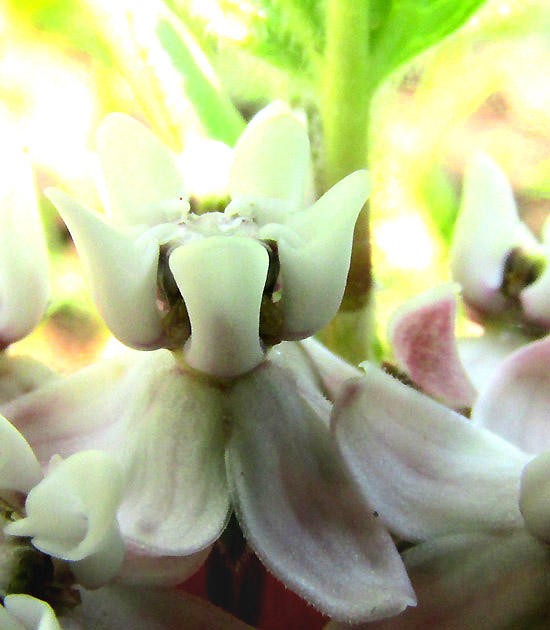Excerpts from Jim Conrad's
Naturalist Newsletter
Entry from field notes dated September 1, 2023, taken in Los Mármoles National Park in the Eastern Sierra Madre mountains, Hidalgo state, MÉXICO; oak-pine forests along ridge beside road leading to Puerto de Piedra, which branches off the road between Trancas {on maps designated "Morelos (Trancas)"} and Nicolás Flores; limestone bedrock; elevation ~2,550m (~8,400ft); ~N20.81°, ~W99.23°
ASCLEPIAS JORGEANA

An herb with large leaves for such a small plant, occurring in pairs on the stem, and whose slightly fleshy blades are simple with no lobes or teeth along their margins, and the plant producing vaguely flat-topped clusters of closely packed, very distinctive looking flowers... has to be a milkweed. Milkweeds belong to the genus Asclepias of the big Dogbane Family, the Apocynaceae, which embraces not only milkweeds but also such popular ornamentals as periwinkle, oleander and frangipani. The above plant, emerging from a shady forest floor beneath ridgetop oaks and pines, is a little smaller and more delicate than most milkweed species.

Over 200 milkweed species occur in the Americas and Africa, with about 68 found in Mexico. The 2021 work by José Luis Villaseñor and others entitled "Riqueza y distribución de la flora vascular del estado de Hidalgo, México" reports that here in upland central Mexico's Hidalgo state 18 species are documented. Several of these species are very similar to one another so, for identification to species level, subtle features must be noted.
Above, important field marks include the five slender, fingerlike horns curving from their shoelike hoods, and extending well over the flat, white, starshaped stigma head. A particularly nice detail in the above picture is seen with the pale brown structures between the bases of the hoods appearing at the picture's top. Those are guide rails, which help guide pollinator legs into position so that they snag into the acute angle of the upside-down-Y shaped pollinarium, which bears one or two tiny waxy packages of pollen known as pollinia. Probably all milkweed flowers have them, but they rarely are seen as clearly as in this image.

Above, it's seen that the hoods are about a third higher than the stigma head. Note that hood bases do not expand into winglike structures, nor do they reduce to stemlike stalks. The whole assemblage of the flower's upper parts stand atop a short, thick stalk which isn't as tall and slender, as in many species, or completely absent. The five petals below the stalk are not directed downward as strongly as in some species. The whole flower is white, but with a slight rosy hue on the petals.

As seen at the right, the leaves are moderately wide and narrowly oval in shape, with their bases not quite rounded where they attach to the petioles. Petioles are well formed but not especially long. Blade veins are softly white-hairy, with veins at blade bases bearing longer hairs; blade surfaces were only sparsely hairy.
Our milkweed is one of several very similar and apparently closely related species occurring in this part of Mexico. It wasn't even formally recognized as a distinct taxon until 1999 when Steven Lynch of Louisiana State University with Mark Fishbein of the University of Arizona as the senior author formally described the species in a work entitled "Asclepias jorgeana (Asclepiadaceae), a New Milkweed from Montane Western Mexico." At that time it was considered a species endemic just to northwestern Mexico, but now it's known that an apparently separate population occurs in our area, one or two states farther southeast, constituting a disjunct population.
Our plant is ASCLEPIAS JORGEANA, with no English name, though if someday it acquires one probably it'll be Jorge's Milkweed or, even more anglicized, George's Milkweed. It's named in honor of George Ferguson, a friend of Lynch at the University of Arizona.
The authors write that "Asclepias jorgeana is unusual among North American milkweeds by inhabiting dense forest understories rather than more typical open woodland and grassland sites," and that's my appraisal, too. It just felt odd finding our plant all alone in deep shade beneath the oaks and pines.
The authors further say that our Asclepias jorgeana is most similar to Asclepias pringlei. If you compare pictures of the two species, the easiest to see difference between them is observed at the bases of the flowers' hoods. The hoods of Asclepias pringlei narrow to a kind of stem at their bases, which isn't the case with Asclepias jorgeana.
That may seem an insignificant difference, but remember that the flower's function is to accomplish pollination. The hood's shape represents a flower's first effort to guide the pollinator's legs between the guide rails, and snag on a pollen-bearing pollinarium. One assumes that each hood shape favors one pollinator or set of pollinators over another, thus allowing two species to coexist without competing for pollinators. This increases ecosystem diversity, which always is a prime motive of evolution, and Nature in general.